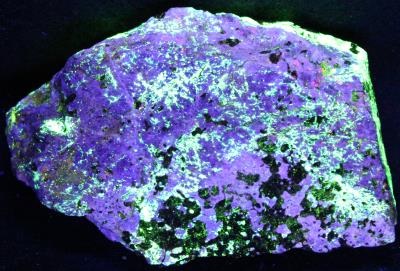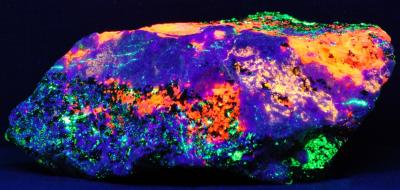 | |  |
Hardystonite, willemite and franklinite, from Franklin, NJ. Photo by WP.
| | Hardystonite, willemite and franklinite, from Franklin, NJ under shortwave UV light. The hardystonite fluoresces light violet and willemite green, franklinite is non-fluorescent. Photo by WP. |
 |
Hardystonite, willemite and franklinite, from Franklin, NJ under longwave UV light. The hardystonite fluoresces cream to white (uncommon) and light violet, franklinite is non-fluorescent. Photo by WP.
|
|
 | |  |
Hardystonite, willemite, esperite, franklinite and minor calcite from Franklin, NJ. 4 3/4" x 3 5/8". From the collection of, and photo by Robert A. Boymistruk.
| | Hardystonite, willemite, esperite, franklinite and minor calcite from Franklin, NJ under shortwave UV light. 4 3/4" x 3 5/8". The hardystonite fluoresces violet, willemite green, esperite yellow and calcite red-orange, the franklinite is non-fluorescent. From the collection of, and photo by Robert A. Boymistruk. |
|
 | |  |
Hardystonite, clinohedrite, willemite, calcite, franklinite (black) and zincite (light orange brown) from Franklin, New Jersey. 5 1/4" x 3 7/8". From the collection of, and photo by Robert A. Boymistruk.
| | Hardystonite, clinohedrite, willemite, calcite, franklinite and zincite from Franklin, NJ under shortwave UV light. The hardystonite fluoresces violet blue, calcite red orange, willemite green and clinohedrite orange, and the franklinite is non-fluorescent. 5 1/4" x 3 7/8". From the collection of, and photo by Robert A. Boymistruk. |
|
 | |  |
Hardystonite, clinohedrite, willemite, calcite, garnet (dark brown) and franklinite (black) from Franklin, New Jersey. 5 3/8" x 3 1/4". From the collection of, and photo by Robert A. Boymistruk.
| | Hardystonite, clinohedrite, willemite, calcite, garnet and franklinite from Franklin, NJ under shortwave UV light. The hardystonite fluoresces violet blue, calcite red orange, willemite green and clinohedrite orange, the garnet and franklinite are non-fluorescent. 5 3/8" x 3 1/4". From the collection of, and photo by Robert A. Boymistruk. |
|
 | |  |
Hardystonite vein, willemite, calcite and franklinite (black) from Franklin, New Jersey. 10" x 6". Photo by WP.
| | Hardystonite vein, willemite, calcite, and franklinite from Franklin, NJ under shortwave UV light. The hardystonite fluoresces violet blue, calcite red orange and willemite green, the franklinite is non-fluorescent. 10" x 6". Photo by WP. |
|
